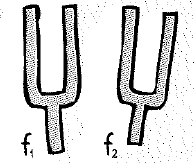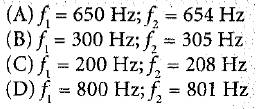
Concept explainers
A pair of tuning forks of frequencies

Rank from greatest to least the beat frequencies produced by the following pairs of tuning forks.
(A)
(B)
(C)
(D)
To rank the beat frequency of the given pairs of frequencies.
Answer to Problem 23A
1: (C) f1= 200 Hz, f2= 208 Hz
2: (B) f1= 300 Hz, f2= 305 Hz
3: (A) f1= 650 Hz, f2= 654 Hz
4: (D) f1=800 Hz, f2=801 Hz
Explanation of Solution
Given info:
The frequency pairs are

Formula used:
The beat frequency is
Calculation:
Substituting the given values, we get
Conclusion:
Thus, the rank of the beat frequency from greatest to least is
1: (C) f1= 200 Hz, f2= 208 Hz
2: (B) f1= 300 Hz, f2= 305 Hz
3: (A) f1= 650 Hz, f2= 654 Hz
4: (D) f1=800 Hz, f2=801 Hz
Chapter 26 Solutions
Conceptual Physics: The High School Physics Program
Additional Science Textbook Solutions
Campbell Essential Biology (7th Edition)
Organic Chemistry (8th Edition)
Concepts of Genetics (12th Edition)
Campbell Biology (11th Edition)
Chemistry: An Introduction to General, Organic, and Biological Chemistry (13th Edition)
Microbiology: An Introduction
- Example Two charges, one with +10 μC of charge, and another with - 7.0 μC of charge are placed in line with each other and held at a fixed distance of 0.45 m. Where can you put a 3rd charge of +5 μC, so that the net force on the 3rd charge is zero?arrow_forward* Coulomb's Law Example Three charges are positioned as seen below. Charge 1 is +2.0 μC and charge 2 is +8.0μC, and charge 3 is - 6.0MC. What is the magnitude and the direction of the force on charge 2 due to charges 1 and 3? 93 kq92 F == 2 r13 = 0.090m 91 r12 = 0.12m 92 Coulomb's Constant: k = 8.99x10+9 Nm²/C² ✓arrow_forwardMake sure to draw a Free Body Diagram as wellarrow_forward
 College PhysicsPhysicsISBN:9781305952300Author:Raymond A. Serway, Chris VuillePublisher:Cengage Learning
College PhysicsPhysicsISBN:9781305952300Author:Raymond A. Serway, Chris VuillePublisher:Cengage Learning University Physics (14th Edition)PhysicsISBN:9780133969290Author:Hugh D. Young, Roger A. FreedmanPublisher:PEARSON
University Physics (14th Edition)PhysicsISBN:9780133969290Author:Hugh D. Young, Roger A. FreedmanPublisher:PEARSON Introduction To Quantum MechanicsPhysicsISBN:9781107189638Author:Griffiths, David J., Schroeter, Darrell F.Publisher:Cambridge University Press
Introduction To Quantum MechanicsPhysicsISBN:9781107189638Author:Griffiths, David J., Schroeter, Darrell F.Publisher:Cambridge University Press Physics for Scientists and EngineersPhysicsISBN:9781337553278Author:Raymond A. Serway, John W. JewettPublisher:Cengage Learning
Physics for Scientists and EngineersPhysicsISBN:9781337553278Author:Raymond A. Serway, John W. JewettPublisher:Cengage Learning Lecture- Tutorials for Introductory AstronomyPhysicsISBN:9780321820464Author:Edward E. Prather, Tim P. Slater, Jeff P. Adams, Gina BrissendenPublisher:Addison-Wesley
Lecture- Tutorials for Introductory AstronomyPhysicsISBN:9780321820464Author:Edward E. Prather, Tim P. Slater, Jeff P. Adams, Gina BrissendenPublisher:Addison-Wesley College Physics: A Strategic Approach (4th Editio...PhysicsISBN:9780134609034Author:Randall D. Knight (Professor Emeritus), Brian Jones, Stuart FieldPublisher:PEARSON
College Physics: A Strategic Approach (4th Editio...PhysicsISBN:9780134609034Author:Randall D. Knight (Professor Emeritus), Brian Jones, Stuart FieldPublisher:PEARSON





